Capybara Animal Facts
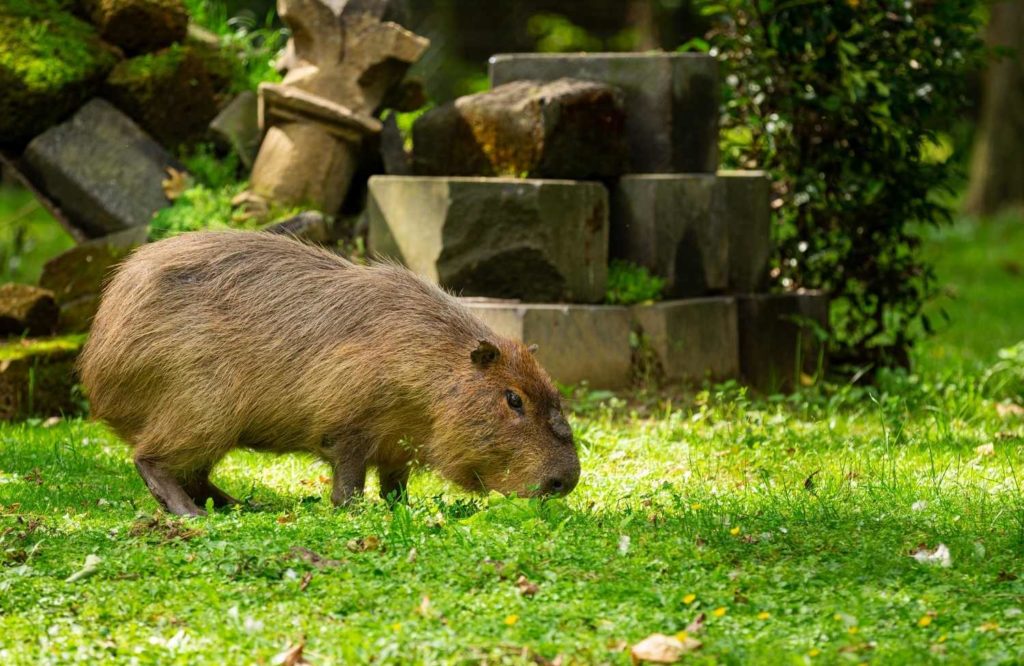
Capybara, also called ‘Carpincho’ or ‘Water hog’, is a semi-aquatic rodent species. The close relatives of Capybara are the ‘guinea pigs’ and ‘rock cavies’. The Capybara is a social species and lives together in groups.
These animals are well adapted to a semi-aquatic lifestyle. They are both excellent divers and swimmers. A constant source of water is essential for their survival.
Along with the Capybara, there are two other species of animals that belong to the same subfamily. They are the ‘lesser Capybara’ and the ’rock cavies’.
What does a Capybara look like?
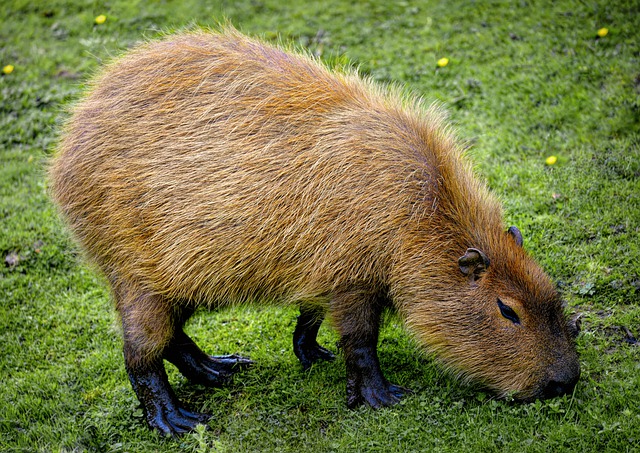
Capybaras have shorter heads as compared to their body. Their facial features are on the top part of their heads. This allows them to see and breathe underwater. They have a heavy cylindrical body with reddish-brown to yellowish-brown fur. They have small ears that they press against their head when submerged underwater. They do so to prevent water from entering.
The Capybara have slight to no hair on their bodies. Females are fractionally heavier than males. Capybaras have slightly longer hind legs. Their feet are webbed to help them swim. They also have small tails.
How big are Capybaras?
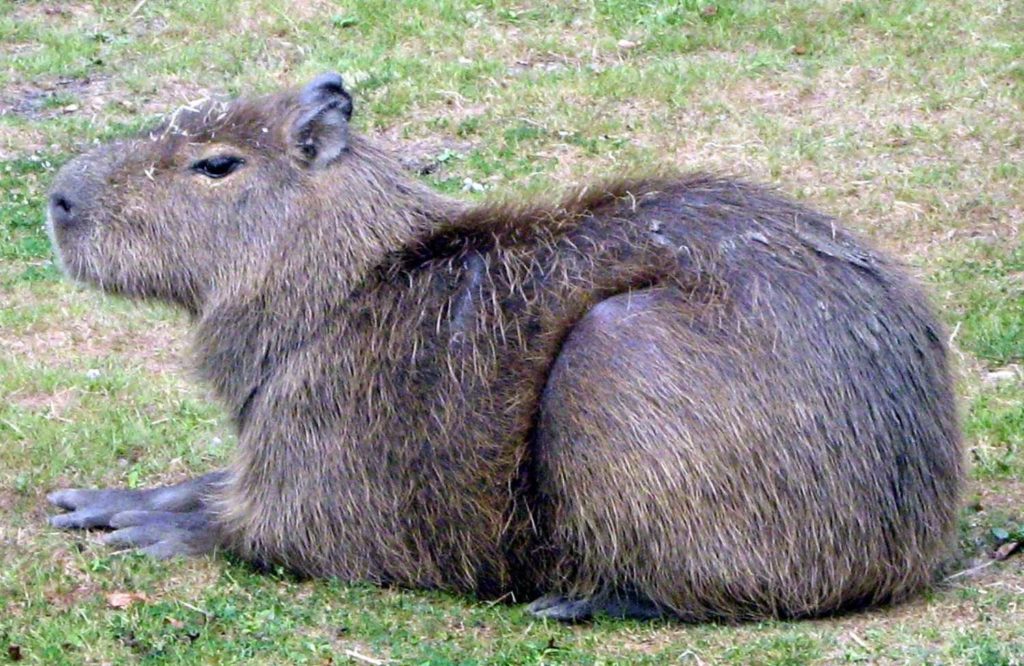
Capybaras are four ft. (130 cm) in length, 50-60 cm at the shoulders, and weigh between 35-70 kg. This allows Capybaras to claim the title of ‘world’s largest rodent’.
Where do Capybaras Live?
Capybaras inhabit forests and wetlands. We find them in parts of Central and Southern America, where freshwater sources are available. They are also found in Peru, Panama, Venezuela, Columbia, Brazil, and Paraguay. In the north, they are found in Argentina and Uruguay. They can also be found occupying regions in grassy plains and rainforests.
What do Capybaras eat?
Capybaras are herbivores and feed on grasses and aquatic plants. This helps them cool off and avoid the heat. They come out to graze when it is cool.
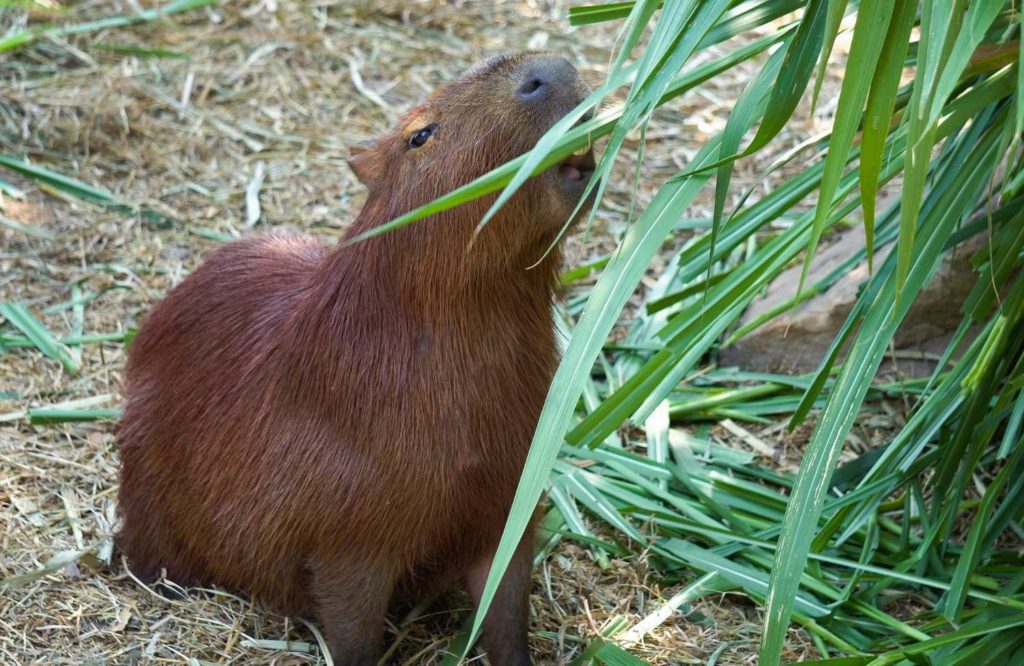
On average, they consume 3-3.5 kg per day. Capybaras eat a larger variety of plants during the dry season. They switch to a wide variety as the plants they eat in the dry season lose nutritional value during the winter. During this season, they eat squashes, melon and grains.
Capybaras have a unique digestive system. It allows them to absorb more nutrients for a highly fibrous diet. Capybara is auto coprophagous. They eat their droppings as it is a source of bacteria that contributes to gut flora. These bacteria, along with enzymes and a few gases, aid in digestion. Coprophagy also allows them to ingest a good amount of proteins.
Capybara Classification
Capybara belongs to the family ‘Caviidae’. Their genus is ‘Hydrochoerus’. Their species name is ‘H. Hydrochaeris’. The scientific name given to the Capybara is ‘Hydrochoerus Hydrochaeris’.
The lesser Capybara also belongs to the same family and the same genus. Yet, they are an entirely different species. Their species name is ‘H. Isthmius’. Their scientific name is ‘Hydrochoerus Isthmius’.
Are Capybaras Rodents?
As mentioned above, Capybaras are a type of rodent that are semi-aquatic. They can adapt well to both land and water. They are also considered the largest rodents in the world.
How long do Capybaras live?
The lifespan of a Capybara is anywhere between 8-10 years. In special enclosures, they may be able to live longer.
Capybaras Behavior and Personality Traits
Capybaras are very sociable animals and tend to live in densely vegetated areas. They are generally quite gentle. This allows them to live side by side with many different species. Capybaras are playful. They are also quite noisy. They constantly grunt, whistle and squeal. When they sense danger, they even bark to warn the others.
Are Capybaras Friendly?
Capybaras are very friendly and usually do not become aggressive. As they are peaceful animals, they generally do not tend to attack others. They may attack if threatened or provoked.
Can you have a Capybara as a pet?
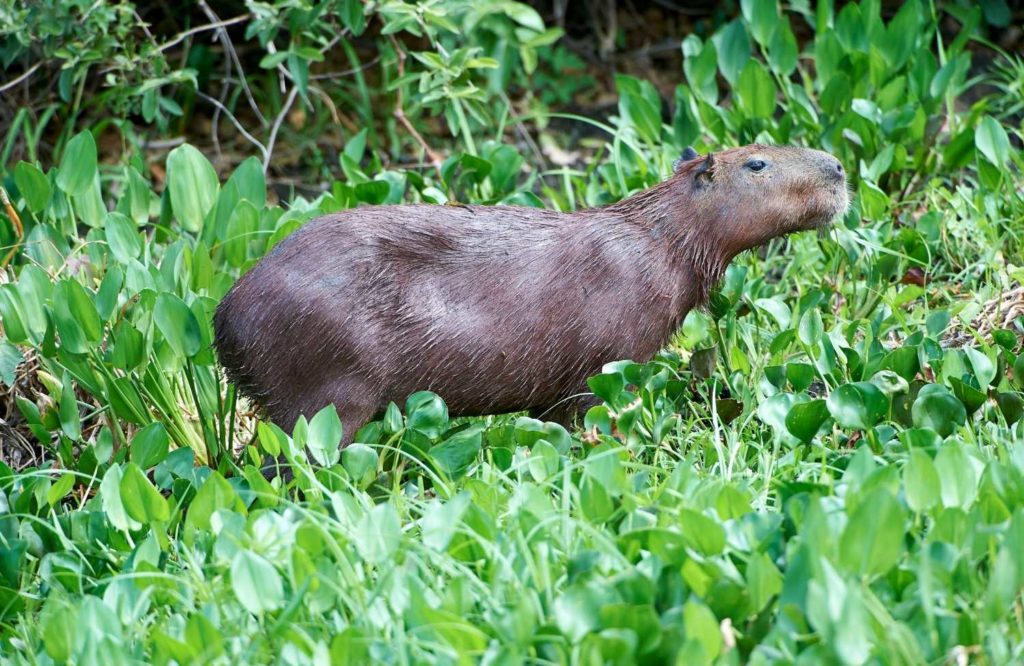
Generally speaking, yes! You can have a Capybara as a pet. They are smart, friendly, and affectionate animals. However, it is not very easy to take care of them. They are large rodents and need vast spaces. They also need a pool that they can access at any time.
Capybaras are easy to tame when reared from childhood. They are calm creatures. Only when threatened or provoked, will they use their giant teeth to protect themselves. Capybaras generally tend to be shy and nervous.
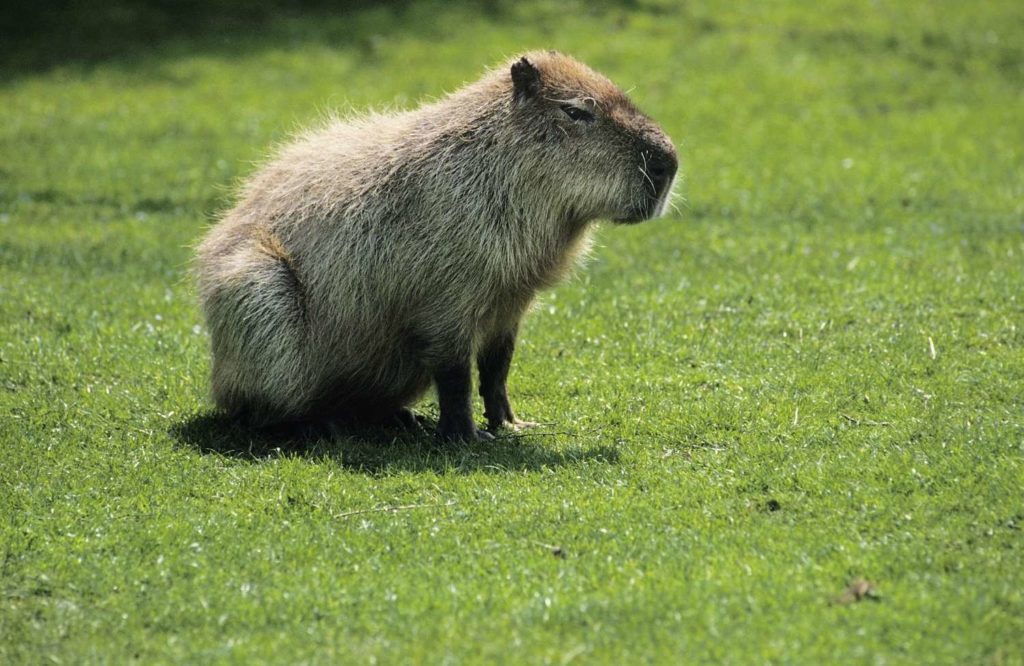
As Capybaras are social by nature, it is advisable to keep them in pairs. It is advisable to have one male and one female if they are in pairs. If there are too many male Capybaras in a single enclosure, it will lead to territorial fights.
As a whole, keeping Capybaras as pets can be a fruitful experience! While many places allow keeping Capybaras as pets, it is not legal everywhere.
What do you call a group of Capybaras?
Capybaras always live together in groups. They usually live in groups of around 10-30 each. A group of Capybaras is known as a ‘Herd’.
Playing in the Mud
During the hot seasons, Capybaras usually wallow in shallow water bodies and mud. They use the mud as a means to regulate their body temperature. They cannot stay out in the harsh sun as they are prone to sunburns. They have thin fur and do not have many sweat glands.
Capybara Physical Traits
Strong Swimmers
Being semi-aquatic, Capybaras are excellent swimmers. They have webbed feet that help them swim underwater. They use the water as a means to hide and escape from predators. They can hold their breath and stay underwater for up to 5 minutes.
Like hippos, they swim by keeping only the upper part of their faces above water. As temperatures increase in the afternoons, they wallow deeper into the water.
Able-Bodied on Land
Like most rodents, they are comfortable on land. They can traverse on land with agility despite their large size. Their webbed feet even help them move on soft and muddy grounds.
Long Front Teeth
As Capybaras are rodents, they share some common traits with squirrels and mice. Capybaras have long, sharp front teeth that help them bite and chew. They need these large teeth for grazing on grass and aquatic plants.
Even though they are rodents, they can also ruminate. Like cows and other cattle, Capybaras also chew their food longer.
Highly Intelligent
Capybaras are smart creatures. They have a lot of complex emotions and feelings. It is said that they are at least as intelligent as some of the smartest dogs. If Capybaras stay alone for long periods, they can even go into depression!
Breeding in Capybaras
During the mating season, the scent of the female Capybara changes. This scent attracts many males towards the female. During mating, the female has the right to choose her mate. Capybaras mate only in water. If the female does not want to mate with a particular male, she leaves or immerses herself in the water.
Baby Capybara
The gestation period for a Capybara is around 130-150. After this gestation period of 5 months, females produce a litter of 1-8 babies. An average of about 4-5 is in a single litter. The mother and the newborns rejoin the group as soon as they are ready to move. When they rejoin, all the newborns are nursed together by all the females. This allows all the offspring to be together in one single group.
The young can feed on grass within a few weeks. They learn all their responsibilities while in the group as a whole. Baby Capybaras are unable to swim at first. Hence they stay on land. Their small body and inability to swim make them easy prey for larger animals.
Capybara Family Life
As mentioned earlier, Capybaras usually stay in groups of 10-30. The group consists of females and a few males. A group of Capybaras generally has a ratio of one male to two females. The ‘dominant male’ heads the group. A dominant male has the right to mate with all the females of the group. He also enjoys a position where he is safe from immediate danger.
Other males also have the right to challenge the dominant male for his position. Most of the males are left at the edges of the group. Their job is to look out for any danger and warn the group.
Many times, juvenile males are forced outside the group when they reach maturity. They are left to fend for themselves. They often fall prey to predators as they do not have the protection of the group.
Capybara Predators
Capybaras get preyed upon by jaguars, piranhas, ocelots, pumas, eagles, vultures, foxes, and wild dogs. They are the favorite food of the anacondas. Their natural enemies are the anaconda and the jacare. But, Capybaras do have the means to escape from such predators.
How do Capybaras defend themselves?
Being in groups and having a social lifestyle, Capybaras have scouts in their group. These scouts consist of males. These males warn the rest of the group from the approaching danger.
They bark to warn the group. When the group realizes, they hide under shady bushes or dive into the water.
This proves to be a helpful strategy as they are excellent swimmers.
Are Capybaras Endangered?
Capybaras are not an endangered species. Their population is large and is non-threatened. However, Capybaras are severely threatened in some parts of the world. People hunt them for their skin. People also eat Capybara meat, especially before Easter. Hence, their population started to dwindle in certain countries. Seeing this, the authorities placed hunting restrictions, and their population is now stable.
Facts About Capybaras
- In the olden days, people thought that Capybaras were a type of pig.
- They are also known as water pigs.
- As the food they eat is tough and causes wear and tear, their teeth never stop growing!
- They are often referred to as ‘moving chairs’. This is because they allow smaller critters such as birds to perch on them.
Conclusion
In conclusion, the capybara is a fascinating animal known for its unique appearance, large size, and adaptable habitat. It is the largest rodent in the world and is native to South America, where it thrives in various environments such as forests, marshes, and grasslands. Capybaras have several notable features, including their semi-aquatic lifestyle, social behavior, and herbivorous diet. With their friendly nature and interesting characteristics, capybaras continue to capture the curiosity and admiration of people around the world.
FREQUENTLY ASKED QUESTIONS
1. Are capybaras social animals? Do they live in groups or alone?
Capybaras are highly social animals and they typically live in large groups known as herds. They are known for their strong social bonds and often engage in cooperative behaviors. It is rare to find a capybara living alone in the wild.
2. Can capybaras be kept as pets? Are there any legal restrictions on owning them?
While capybaras can be appealing as pets, it’s important to note that their ownership is regulated in many countries and regions. In some places, they may require special permits or licenses to keep as pets due to their natural habitat and specific care needs. Researching and understanding the legal restrictions and requirements is crucial before considering a capybara as a pet.
3. Do capybaras swim? Are they adapted to an aquatic lifestyle?
Capybaras are excellent swimmers and are well-adapted to an aquatic lifestyle. They have partially webbed feet, allowing them to easily navigate through water. Their eyes, nostrils, and ears are located on the top of their head, enabling them to submerge most of their body while remaining alert to potential threats. Capybaras often use water as a means of escape from predators and to regulate their body temperature.
